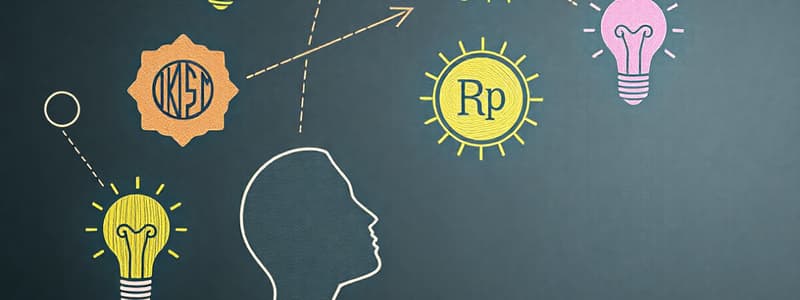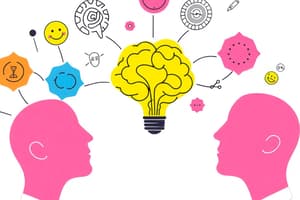Podcast
Questions and Answers
Lonnie Johnson's invention of the Super Soaker water gun exemplifies creativity as:
Lonnie Johnson's invention of the Super Soaker water gun exemplifies creativity as:
- A result of intentionally setting out to invent a new toy.
- A product developed solely through brainstorming sessions.
- An unintended outcome of working on a different problem. (correct)
- A direct application of his work on refrigeration systems.
Which of the following scenarios best demonstrates everyday creativity, as described in the content?
Which of the following scenarios best demonstrates everyday creativity, as described in the content?
- Finding an efficient way to organize items in a small storage space. (correct)
- Writing a standard operating procedure for a routine task.
- Developing a new marketing strategy for a product.
- Following a recipe precisely to bake a cake.
According to the content, what is the primary role of management in fostering creativity within an organization?
According to the content, what is the primary role of management in fostering creativity within an organization?
- Directing employees towards specific creative tasks.
- Creating an environment that supports and encourages creative thinking. (correct)
- Implementing strict rules to guide creative processes.
- Hiring individuals with innate creative abilities.
Which component of the personal creativity drivers model emphasizes the importance of having a deep understanding of the task at hand?
Which component of the personal creativity drivers model emphasizes the importance of having a deep understanding of the task at hand?
The 'right brain' thinking style is most closely associated with which of the following?
The 'right brain' thinking style is most closely associated with which of the following?
What does the example of elevator riders in the high rise building illustrate about creativity?
What does the example of elevator riders in the high rise building illustrate about creativity?
Why might mixing creative individuals with traditional organizational practices not automatically lead to innovation?
Why might mixing creative individuals with traditional organizational practices not automatically lead to innovation?
The story of RCA's liquid-crystal display (LCD) technology demonstrates what challenge in fostering organizational creativity?
The story of RCA's liquid-crystal display (LCD) technology demonstrates what challenge in fostering organizational creativity?
According to the content, what is a key aspect of situational creativity drivers within innovative organizations?
According to the content, what is a key aspect of situational creativity drivers within innovative organizations?
What is the purpose of innovation spaces, such as the 'Cave' at Fisher-Price headquarters?
What is the purpose of innovation spaces, such as the 'Cave' at Fisher-Price headquarters?
The Motorola Razr example illustrates the importance of what in the innovation process?
The Motorola Razr example illustrates the importance of what in the innovation process?
What is the primary consideration when determining whether to make a decision individually or as a group?
What is the primary consideration when determining whether to make a decision individually or as a group?
Which of the following is an advantage of group decision-making?
Which of the following is an advantage of group decision-making?
When is group decision-making most appropriate, according to the content?
When is group decision-making most appropriate, according to the content?
Minority domination in group decision-making refers to what situation?
Minority domination in group decision-making refers to what situation?
What is the primary purpose of the 'ethics double-check' questions?
What is the primary purpose of the 'ethics double-check' questions?
The 'spotlight questions' in ethical decision-making ask individuals to consider:
The 'spotlight questions' in ethical decision-making ask individuals to consider:
What is the central question posed by the Josephson Institute model for ethical decision-making?
What is the central question posed by the Josephson Institute model for ethical decision-making?
According to Gerald Cavanaugh's criteria for ethics in decision-making, 'utility' refers to:
According to Gerald Cavanaugh's criteria for ethics in decision-making, 'utility' refers to:
In the context of ethical decision-making, what does 'justice' entail?
In the context of ethical decision-making, what does 'justice' entail?
Flashcards
What is Creativity?
What is Creativity?
The generation of a novel idea or unique approach that solves a problem or takes advantage of an opportunity.
Personal Creativity Drivers
Personal Creativity Drivers
Task expertise, task motivation, and creativity skills. These drive personal creativity.
Task Expertise in Creativity
Task Expertise in Creativity
Creative decisions are more likely when the person or team has a lot of task expertise.
"Right Brain" Thinking
"Right Brain" Thinking
Imagination, intuition, spontaneity, and emotion.
Signup and view all the flashcards
"Left Brain" Thinking
"Left Brain" Thinking
Logic, order, method, and analysis.
Signup and view all the flashcards
Situational Creativity Drivers
Situational Creativity Drivers
Mix of creative people and organizational support to make innovation a way of life.
Signup and view all the flashcards
Situational Creativity Components
Situational Creativity Components
Group creativity skills, management support, and organizational culture.
Signup and view all the flashcards
Advantages of Group Decisions
Advantages of Group Decisions
Decisions that involve team members make greater amounts of information, knowledge, and expertise available to solve problems.
Signup and view all the flashcards
When Group Decisions Work Best
When Group Decisions Work Best
Individual lacks expertise/information. Problem is unclear. Acceptance is needed. There is sufficient time.
Signup and view all the flashcards
Disadvantages of Group Decisions
Disadvantages of Group Decisions
Social pressure, minority domination, and time required to make team decisions.
Signup and view all the flashcards
Utility in Ethical Decision-Making
Utility in Ethical Decision-Making
Does the decision satisfy all constituents or stakeholders?
Signup and view all the flashcards
Rights in Ethical Decision-Making
Rights in Ethical Decision-Making
Does the decision respect the rights and duties of everyone?
Signup and view all the flashcards
Justice in Ethical Decision-Making
Justice in Ethical Decision-Making
Is the decision consistent with the canons of justice?
Signup and view all the flashcards
Caring in Ethical Decision-Making
Caring in Ethical Decision-Making
Is the decision consistent with my responsibility to care?
Signup and view all the flashcardsStudy Notes
Creativity in Decision-Making
- Creativity is defined as the generation of a novel idea or unique approach to solving a problem or taking advantage of an opportunity.
- Lonnie Johnson invented the Super Soaker water gun while working on an alternative refrigeration system.
- Creativity is a valuable personal asset that is often underutilized.
- Organizations can benefit from harnessing the creative potential of their workforce.
Personal Creativity Drivers
- Personal creativity is influenced by task expertise, task motivation, and creativity skills.
- Task expertise means that creative decisions are more likely when the person or team has considerable knowledge, skill, and experience.
- Task motivation means that creative people often work hard to resolve a problem or exploit an opportunity.
- Creative people tend to: work with high energy, identify and plan around problems, accept responsibility, are resourceful, use systematic and intuitive thinking, think "outside of the box" (divergent thinking), synthesize and find correct answers (convergent thinking), look at diverse ways to solve problems (lateral thinking), transfer learning, question assumptions.
Situational Creativity Drivers
- Individual creativity alone is insufficient for organizational innovation.
- Organizational culture plays a key role in developing creative products like the Apple iPhone.
- RCA executives failed to capitalize on the invention of the LCD because they were too invested in color TV tubes.
- Situational creativity drivers include group creativity skills, management support, and organizational culture.
- Supportive management and organizational cultures give group creativity skills a chance to flourish by providing resources ($$, tech, space) and valuing creativity through rewards and peer expectations.
- Innovation spaces (e.g., the "Cave" at Fisher-Price) can help foster freewheeling brainstorming sessions.
Individual Versus Group Decision-Making
- Groups and teams play an important role as sources of creativity in decision-making.
- Managers should use group decision-making where appropriate to encourage this.
- The manager's choice to use or not use group decision-making can have a turning point on the results achieved.
- Management scholars promote that the best managers and team leaders are dynamic with their use of individual v. group decisions, and use the appropriate method respective to the specific scenario to ensure a solution of good quality and timeliness.
Advantages of Group Decisions
- Group decisions can be valuable when time and circumstances permits.
- Group decisions bring more information, knowledge, and expertise to problem-solving.
- Expanding number of action alternatives leads to less tunnel vision with more options considered.
- Group decisions increase understanding and acceptance among members.
- Group decisions also increase commitment to implementing the decision.
Disadvantages of Group Decisions
- When making team decisions there may be social pressure to conform, people may feel intimidated.
- Minority domination may occur, where a small group forces a decision.
- Team decisions typically take longer than individual decisions.
When Group Decisions Work Best
- Individual lacks expertise or information.
- Problems are unclear and hard to define.
- Acceptance by others is needed for effective implementation.
- Time is sufficient for group involvement.
Ethical Decision-Making
- The "ethics double-check" involves asking yourself: "How would I feel if my family found out about this decision?" and "How would I feel if this decision were published?".
- The Josephson Institute model adds a third question: "What would the person I know with the strongest character do?".
- Ethical decision-making helps ensure that the ethical aspects of the problem are properly considered and can have a potential for a better decision.
- Ethicist Gerald Cavanaugh suggests managers can have confidence in ethics for decision-making when: the decision satisfies all stakeholders (Utility), respects the rights of everyone (Rights), consistent with the canons of justice (Justice), and consistent with my responsibility to care (Caring).
Studying That Suits You
Use AI to generate personalized quizzes and flashcards to suit your learning preferences.




